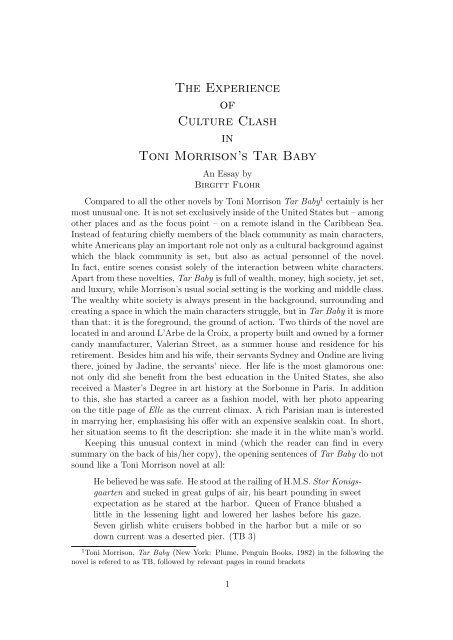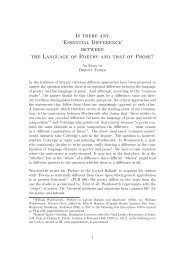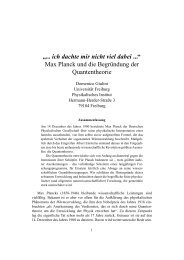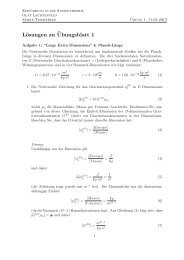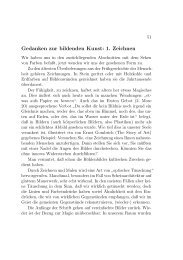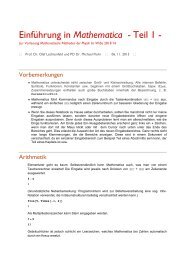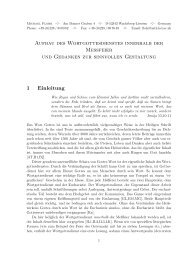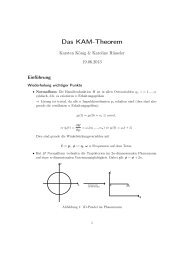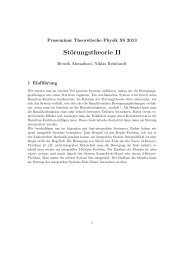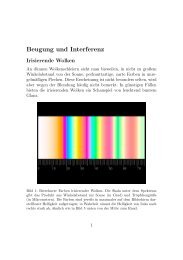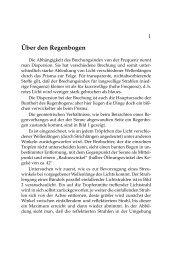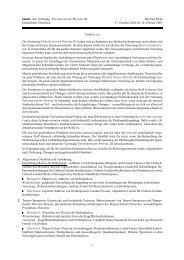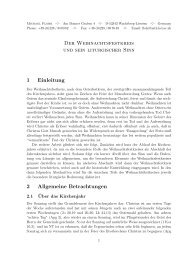The Experience of Culture Clash in Toni Morrison's Tar Baby
The Experience of Culture Clash in Toni Morrison's Tar Baby
The Experience of Culture Clash in Toni Morrison's Tar Baby
You also want an ePaper? Increase the reach of your titles
YUMPU automatically turns print PDFs into web optimized ePapers that Google loves.
<strong>The</strong> <strong>Experience</strong><br />
<strong>of</strong><br />
<strong>Culture</strong> <strong>Clash</strong><br />
<strong>in</strong><br />
<strong>Toni</strong> Morrison’s <strong>Tar</strong> <strong>Baby</strong><br />
An Essay by<br />
Birgitt Flohr<br />
Compared to all the other novels by <strong>Toni</strong> Morrison <strong>Tar</strong> <strong>Baby</strong> 1 certa<strong>in</strong>ly is her<br />
most unusual one. It is not set exclusively <strong>in</strong>side <strong>of</strong> the United States but – among<br />
other places and as the focus po<strong>in</strong>t – on a remote island <strong>in</strong> the Caribbean Sea.<br />
Instead <strong>of</strong> featur<strong>in</strong>g chiefly members <strong>of</strong> the black community as ma<strong>in</strong> characters,<br />
white Americans play an important role not only as a cultural background aga<strong>in</strong>st<br />
which the black community is set, but also as actual personnel <strong>of</strong> the novel.<br />
In fact, entire scenes consist solely <strong>of</strong> the <strong>in</strong>teraction between white characters.<br />
Apart from these novelties, <strong>Tar</strong> <strong>Baby</strong> is full <strong>of</strong> wealth, money, high society, jet set,<br />
and luxury, while Morrison’s usual social sett<strong>in</strong>g is the work<strong>in</strong>g and middle class.<br />
<strong>The</strong> wealthy white society is always present <strong>in</strong> the background, surround<strong>in</strong>g and<br />
creat<strong>in</strong>g a space <strong>in</strong> which the ma<strong>in</strong> characters struggle, but <strong>in</strong> <strong>Tar</strong> <strong>Baby</strong> it is more<br />
than that: it is the foreground, the ground <strong>of</strong> action. Two thirds <strong>of</strong> the novel are<br />
located <strong>in</strong> and around L’Arbe de la Croix, a property built and owned by a former<br />
candy manufacturer, Valerian Street, as a summer house and residence for his<br />
retirement. Besides him and his wife, their servants Sydney and Ond<strong>in</strong>e are liv<strong>in</strong>g<br />
there, jo<strong>in</strong>ed by Jad<strong>in</strong>e, the servants’ niece. Her life is the most glamorous one:<br />
not only did she benefit from the best education <strong>in</strong> the United States, she also<br />
received a Master’s Degree <strong>in</strong> art history at the Sorbonne <strong>in</strong> Paris. In addition<br />
to this, she has started a career as a fashion model, with her photo appear<strong>in</strong>g<br />
on the title page <strong>of</strong> Elle as the current climax. A rich Parisian man is <strong>in</strong>terested<br />
<strong>in</strong> marry<strong>in</strong>g her, emphasis<strong>in</strong>g his <strong>of</strong>fer with an expensive sealsk<strong>in</strong> coat. In short,<br />
her situation seems to fit the description: she made it <strong>in</strong> the white man’s world.<br />
Keep<strong>in</strong>g this unusual context <strong>in</strong> m<strong>in</strong>d (which the reader can f<strong>in</strong>d <strong>in</strong> every<br />
summary on the back <strong>of</strong> his/her copy), the open<strong>in</strong>g sentences <strong>of</strong> <strong>Tar</strong> <strong>Baby</strong> do not<br />
sound like a <strong>Toni</strong> Morrison novel at all:<br />
He believed he was safe. He stood at the rail<strong>in</strong>g <strong>of</strong> H.M.S. Stor Konigsgaarten<br />
and sucked <strong>in</strong> great gulps <strong>of</strong> air, his heart pound<strong>in</strong>g <strong>in</strong> sweet<br />
expectation as he stared at the harbor. Queen <strong>of</strong> France blushed a<br />
little <strong>in</strong> the lessen<strong>in</strong>g light and lowered her lashes before his gaze.<br />
Seven girlish white cruisers bobbed <strong>in</strong> the harbor but a mile or so<br />
down current was a deserted pier. (TB 3)<br />
1 <strong>Toni</strong> Morrison, <strong>Tar</strong> <strong>Baby</strong> (New York: Plume, Pengu<strong>in</strong> Books, 1982) <strong>in</strong> the follow<strong>in</strong>g the<br />
novel is refered to as TB, followed by relevant pages <strong>in</strong> round brackets<br />
1
As a white European reader, it is easy to make up all k<strong>in</strong>ds <strong>of</strong> stories out <strong>of</strong> this<br />
beg<strong>in</strong>n<strong>in</strong>g, none <strong>of</strong> them fitt<strong>in</strong>g a <strong>Toni</strong> Morrison pattern before or after <strong>Tar</strong> <strong>Baby</strong>.<br />
Although the very first sentence suggests that someone has somehow escaped from<br />
an unsafe place and feels secure now – which allows the reader to imag<strong>in</strong>e that<br />
s/he has entered a dangerous or dramatic situation – the playfulness and sexual<br />
implications <strong>of</strong> the next sentences revise this impression: “Sweet expectation”,<br />
blush<strong>in</strong>g, lowered lashes, and bobb<strong>in</strong>g girlish cruisers seem to belong to a romantic<br />
love story, and it is not difficult to th<strong>in</strong>k <strong>of</strong> a reason for some k<strong>in</strong>d <strong>of</strong> escape <strong>in</strong><br />
this context: a hide-and-seek-game, a male rival, or a playful fight between lovers<br />
which will be resolved soon.<br />
Interest<strong>in</strong>g enough, a literary critic familiar with the African-American cultural<br />
background draws a completely different conclusion: regard<strong>in</strong>g the image<br />
<strong>of</strong> a man stand<strong>in</strong>g on the deck <strong>of</strong> a ship, Eleanor Taylor argues that this open<strong>in</strong>g<br />
scene<br />
calls to m<strong>in</strong>d a similar one from a book written 194 years ago. <strong>The</strong><br />
man . . . is rem<strong>in</strong>iscent <strong>of</strong> a man called Equiano <strong>in</strong> <strong>The</strong> Life <strong>of</strong> Olaudah<br />
Equiano or Gustavas Vassa, the African (1789). Equiano’s tale<br />
is a slave narrative recount<strong>in</strong>g the historical and mythical, the terrify<strong>in</strong>g<br />
and mighty passage <strong>of</strong> the African from the oldest world to the<br />
newest. 2<br />
<strong>The</strong>se differences concern<strong>in</strong>g the associations connected with Morrison’s text lead<br />
to what Wendy Hard<strong>in</strong>g and Jacky Mart<strong>in</strong> call the “<strong>in</strong>terface,” 3 which is def<strong>in</strong>ed<br />
as “a process <strong>of</strong> mutual and conflict<strong>in</strong>g occupation <strong>of</strong> one common cultural field”<br />
out <strong>of</strong> two or more directions – so to speak – result<strong>in</strong>g <strong>in</strong> “constant cycles <strong>of</strong> flux<br />
and mutation” (10). Hard<strong>in</strong>g and Mart<strong>in</strong> stress the “<strong>in</strong>creased complexification<br />
and expansion” caused by the <strong>in</strong>terface, where “the underly<strong>in</strong>g dynamic pr<strong>in</strong>ciple<br />
would be . . . <strong>in</strong>terferential rather than dichotomous, multiplicative rather than<br />
reductive” (10). <strong>The</strong> English language itself is, <strong>of</strong> course, such an <strong>in</strong>terface, s<strong>in</strong>ce<br />
it is used by various cultures <strong>in</strong> “mutual and conflict<strong>in</strong>g” ways, <strong>in</strong> which different<br />
mean<strong>in</strong>gs can be l<strong>in</strong>ked to shared phonetic units, spell<strong>in</strong>gs can vary, and new<br />
semantic units can be created out <strong>of</strong> a common ground. <strong>The</strong> effect <strong>of</strong> the <strong>in</strong>terface<br />
on the text is the possibility to produce quite differ<strong>in</strong>g read<strong>in</strong>gs, depend<strong>in</strong>g on<br />
the cultural direction the reader is com<strong>in</strong>g from, and no read<strong>in</strong>g can simply be<br />
disqualified because it is suggested by the “wrong” cultural background. Without<br />
any doubt and as demonstrated above, a white European, an Anglo-American, or<br />
an African-American will read <strong>Tar</strong> <strong>Baby</strong> <strong>in</strong> different ways exactly because <strong>of</strong> the<br />
different associations and cultural <strong>in</strong>formation s/he carries with her/him. At the<br />
same time, the concept <strong>of</strong> the <strong>in</strong>terface, by stress<strong>in</strong>g that “divisions <strong>in</strong> culture<br />
2 Eleanor W. Taylor, “ <strong>The</strong> Fabulous World <strong>of</strong> <strong>Toni</strong> Morrison: <strong>Tar</strong> <strong>Baby</strong>” <strong>in</strong> Critical Essays<br />
on <strong>Toni</strong> Morrison, Nelli Y. McKay, ed. (Boston: G.K. Hall & Co, 1988) 137-138<br />
3 Wendy Hard<strong>in</strong>g and Jacky Mart<strong>in</strong>, A World <strong>of</strong> Difference: An Inter-Cultural Study <strong>of</strong> <strong>Toni</strong><br />
Morrison’s Novels (Westport: Greenwood Press, 1994)<br />
2
are never dichotomous,” 4 po<strong>in</strong>ts out that Morrison’s texts are not <strong>in</strong>accessible<br />
to readers from cultural backgrounds other than hers. <strong>Culture</strong>s always <strong>in</strong>teract<br />
with each other, and the particular <strong>in</strong>teraction between Anglo-American and<br />
African-American culture is already stated <strong>in</strong> the hyphen that connects them. In<br />
<strong>in</strong>terviews 5 <strong>Toni</strong> Morrison repeatedly remarks that, although she writes ma<strong>in</strong>ly<br />
for her people and doesn’t <strong>in</strong>tend to expla<strong>in</strong> African-American culture to a white<br />
audience, just as Dostojewski didn’t expla<strong>in</strong> Russian culture to her, <strong>of</strong> course<br />
everybody is <strong>in</strong> pr<strong>in</strong>ciple able to read and understand her work:<br />
A woman wrote a book on woman writers, and she has an apology <strong>in</strong><br />
the preface <strong>in</strong> which she expla<strong>in</strong>s why the book doesn’t <strong>in</strong>clude any<br />
black woman writers. She says she doesn’t feel qualified to criticize<br />
their work. I th<strong>in</strong>k that’s dishonest scholarship. . . . I feel perfectly<br />
qualified to discuss Emiliy Dick<strong>in</strong>son, or anybody for that matter,<br />
because I assume what Jane Austen and all those people have to say<br />
has someth<strong>in</strong>g to do with life and be<strong>in</strong>g human <strong>in</strong> the world. Why<br />
she could not figure out that the preoccupation <strong>of</strong> black characters<br />
is this as well startled me, as though our lives are so exotic that the<br />
differences are <strong>in</strong>comprehensible. (160)<br />
It should be obvious by now that culture clash plays an important role for the<br />
read<strong>in</strong>g <strong>of</strong> <strong>Toni</strong> Morrison’s novels. It certa<strong>in</strong>ly accounts for the production <strong>of</strong><br />
differ<strong>in</strong>g <strong>in</strong>terpretations which cannot be brushed aside just because the reader is<br />
or is not African-American. I, therefore, want to discuss <strong>in</strong> this essay two <strong>in</strong>terfaces<br />
<strong>in</strong> a more detailed way, that are important for the read<strong>in</strong>g <strong>of</strong> <strong>Tar</strong> <strong>Baby</strong>, the<br />
relation between the <strong>in</strong>dividual and the community, and the concept <strong>of</strong> the role<br />
<strong>of</strong> women. As I <strong>in</strong>tend to show <strong>in</strong> the follow<strong>in</strong>g, the differ<strong>in</strong>g occupation <strong>of</strong> these<br />
cultural fields can cause quite different evaluations concern<strong>in</strong>g the “message” <strong>of</strong><br />
the text.<br />
<strong>The</strong> experience <strong>of</strong> culture clash, however, is not only a subject for the reader<br />
concern<strong>in</strong>g her/his act <strong>of</strong> read<strong>in</strong>g, but also for the text itself on the level <strong>of</strong><br />
its story. 6 Thus, the <strong>in</strong>tended discussion already exists <strong>in</strong>side <strong>of</strong> the novel and<br />
is therefore more relevant for <strong>Tar</strong> <strong>Baby</strong> than for any other book <strong>of</strong> fiction by<br />
Morrison. For that reason the outl<strong>in</strong>ed exploration <strong>of</strong> <strong>in</strong>terfaces will be comb<strong>in</strong>ed<br />
with an exam<strong>in</strong>ation <strong>of</strong> the content <strong>of</strong> the novel, s<strong>in</strong>ce each will be useful to<br />
illum<strong>in</strong>ate the other.<br />
<strong>Culture</strong> clash does not only describe an important characteristic <strong>of</strong> the environment<br />
<strong>Tar</strong> <strong>Baby</strong> is written <strong>in</strong>, but also the novel’s ma<strong>in</strong> subject which circles<br />
around <strong>Toni</strong> Morrison’s remark:<br />
4ibid 6<br />
5Danielle Taylor-Guthrie, ed. Conversations with <strong>Toni</strong> Morrison (Jackson: University Press<br />
<strong>of</strong> Mississippi, 1994)<br />
6I claim that although they <strong>in</strong>fluence and determ<strong>in</strong>e each other the text and the act <strong>of</strong><br />
read<strong>in</strong>g are separate units.<br />
3
Now people choose to be Black. <strong>The</strong>y used to be born Black. That’s<br />
not true anymore. You can be Black genetically and choose not to<br />
be. You can change your m<strong>in</strong>d . . . It’s just a m<strong>in</strong>d-set. 7<br />
What does belong to this “m<strong>in</strong>d-set” and how does it differ from the white one?<br />
<strong>The</strong> <strong>in</strong>itial sett<strong>in</strong>g <strong>of</strong> <strong>Tar</strong> <strong>Baby</strong> reads like “a k<strong>in</strong>d <strong>of</strong> laboratory where racial,<br />
familial, class, and gender expectations [the latter po<strong>in</strong>ts are here seen as subord<strong>in</strong>ated<br />
to the issue <strong>of</strong> race] can be tested.” 8 Located on a remote island <strong>in</strong> the<br />
Caribbean Sea live the ma<strong>in</strong> characters who represent the two cultural concepts<br />
under exam<strong>in</strong>ation. <strong>The</strong>y can be divided <strong>in</strong>to the follow<strong>in</strong>g groups: Valerian<br />
Street, the rich candy manufacturer from Philadelphia, who is spend<strong>in</strong>g his retirement<br />
on the Isle des Chevaliers, and Margaret Street, his wife and former<br />
Beauty Queen <strong>of</strong> Ma<strong>in</strong>e, are members <strong>of</strong> the white American society, whereas<br />
Gideon and Thérèse, natives from the island who are work<strong>in</strong>g as gardener and<br />
washer woman for the Streets, belong to the black community, <strong>in</strong>clud<strong>in</strong>g Son, one<br />
<strong>of</strong> Morrison’s “outlaws”, who lives everywhere and nowhere, because he killed his<br />
wife and her lover, and who escapes from a ship he was work<strong>in</strong>g on to the Isle<br />
des Chevaliers, where he starts liv<strong>in</strong>g <strong>in</strong> the Street household, first <strong>in</strong> a hid<strong>in</strong>g<br />
place, and after his discovery as a guest. Between these two poles, the spectrum<br />
from white to black is covered by the rema<strong>in</strong><strong>in</strong>g household members: closest to<br />
the black community are Sydney and Ond<strong>in</strong>e Childs, both proud “Philadelphia<br />
Negroes,” who work for the Streets as servant and cook, thereby virtually runn<strong>in</strong>g<br />
their household. S<strong>in</strong>ce they separate themselves from the island’s native population,<br />
especially from Gideon and Thérèse whom they regard as <strong>in</strong>ferior, and s<strong>in</strong>ce<br />
they share a lot <strong>of</strong> their employers’ values, they can not be considered as “pure”<br />
members <strong>of</strong> the black community, but as mixed with the white culture represented<br />
by their employers. Even more, <strong>in</strong> fact almost completely immersed <strong>in</strong><br />
the white – not only American but also European – culture is Jad<strong>in</strong>e, the Childs’<br />
niece, who has lived with them s<strong>in</strong>ce her parents had died <strong>in</strong> her childhood. As<br />
a consequence <strong>of</strong> be<strong>in</strong>g brought up <strong>in</strong> the Streets’ household, her education was<br />
paid for by Valerian Street, eventually lead<strong>in</strong>g to her Master’s Degree at the<br />
Sorbonne. Quite contrary to Pecola <strong>in</strong> Morrison’s <strong>The</strong> Bluest Eye, 9 Jad<strong>in</strong>e is a<br />
success <strong>in</strong> white society, <strong>in</strong> particular <strong>in</strong> terms <strong>of</strong> beauty, which is confirmed by<br />
her appearance on the title page <strong>of</strong> Elle as a fashion model. Her eyes may not<br />
be blue, but she satisfies the white concept <strong>of</strong> female beauty to such degree that<br />
she becomes one <strong>of</strong> its icons, simply the Elle. This fact is further proven by a<br />
Parisian man’s <strong>in</strong>tention to marry her. It is certa<strong>in</strong>ly no accident that Jad<strong>in</strong>e<br />
achieves all this <strong>in</strong> the world’s beauty and fashion capital, where the men are<br />
famous for their expertise <strong>in</strong> women, or to be more precise: <strong>in</strong> women’s exterior<br />
7Danielle Taylor-Guthrie, ed. Conversations with <strong>Toni</strong> Morrison (Jackson: University Press<br />
<strong>of</strong> Mississippi, 1994) 236<br />
8Philip Page, Dangerous Freedom: Fusion and Fragmentation <strong>in</strong> <strong>Toni</strong> Morrison’s Novels(Jackson:<br />
University Press <strong>of</strong> Mississippi, 1995) 109<br />
9<strong>Toni</strong> Morrison, <strong>The</strong> Bluest Eye(New York: Plume, Pengu<strong>in</strong> 1994, first published 1970)<br />
4
appearance. <strong>The</strong> Streets’ grown-up son Michael – although absent <strong>in</strong> person –<br />
is another important character <strong>in</strong> the novel who occupies his own position <strong>in</strong><br />
the spectrum between the cultures. He disappo<strong>in</strong>ted his father by choos<strong>in</strong>g not<br />
to take over his candy bus<strong>in</strong>ess and has been work<strong>in</strong>g <strong>in</strong> several areas Valerian<br />
doesn’t value very much. His latest plan is to become an environmental lawyer.<br />
Contrast<strong>in</strong>g Jad<strong>in</strong>e, Michael is concerned about the survival <strong>of</strong> the traditions <strong>of</strong><br />
different cultures and criticizes his parents’ protégé for leav<strong>in</strong>g beh<strong>in</strong>d her cultural<br />
background. S<strong>in</strong>ce Michael keeps some distance to the white society and<br />
is <strong>in</strong>terested <strong>in</strong> explor<strong>in</strong>g and valu<strong>in</strong>g different cultural concepts, he is certa<strong>in</strong>ly<br />
closer to Son, Gideon and Thérèse than Jad<strong>in</strong>e or even Sydney and Ond<strong>in</strong>e.<br />
At the beg<strong>in</strong>n<strong>in</strong>g <strong>of</strong> the novel, the outl<strong>in</strong>ed relations between the representatives<br />
<strong>of</strong> the white and black culture <strong>in</strong> and around Valerian Street’s house L’Arbe<br />
de la Croix are seem<strong>in</strong>gly settled. But with the discovery <strong>of</strong> Son <strong>in</strong> Margaret<br />
Street’s closet, covered tensions, that have been h<strong>in</strong>ted at before, erupt when his<br />
<strong>in</strong>fluence throws the poorly balanced and unstable system <strong>of</strong> the household <strong>in</strong>to<br />
disorder. Margaret, Sydney and Ond<strong>in</strong>e mistrust Son and want to force him to<br />
leave the house. In the heat <strong>of</strong> the moment Sydney even proposes to shoot him.<br />
<strong>The</strong> Childs experience particular difficulties to adjust to Son’s presence and to<br />
his position as a guest, s<strong>in</strong>ce this allows him to sleep close to his hosts <strong>in</strong> the<br />
“white” part <strong>of</strong> the house while they – despite the fact that they are contrary to<br />
Son respectable “Philadelphia Negroes” – have to stay <strong>in</strong> the servants’ quarters.<br />
Valerian, on the other hand and ma<strong>in</strong>ly as a counteraction to his wife’s hysterical<br />
behaviour dur<strong>in</strong>g Son’s discovery, <strong>in</strong>vites the stranger to stay <strong>in</strong> his house until<br />
he can make arrangements for his return to the United States. He feels contempt<br />
for the Childs’ hostile and Jad<strong>in</strong>e’s contradictory response to Son s<strong>in</strong>ce, <strong>in</strong> his<br />
op<strong>in</strong>ion, he belongs to their own people. Valerian’s behaviour, however, is not<br />
<strong>in</strong>formed by a general contempt for racism but by a contempt for – <strong>in</strong> his eyes –<br />
illegitimate racism, which is <strong>in</strong> a way an even more racist response than the one<br />
<strong>of</strong> his employees. Almost as soon as he is discovered, Son starts a relationship<br />
with Jad<strong>in</strong>e which will be characterized by mutual alternat<strong>in</strong>g states <strong>of</strong> attraction<br />
and repulsion. <strong>The</strong> “ma<strong>in</strong> experiment” <strong>in</strong> the “laboratory Isle des Chevaliers”<br />
beg<strong>in</strong>s:<br />
What is the problem between a pair <strong>of</strong> lovers who really love one<br />
another but are culturally different? What is the battle about? <strong>Culture</strong>?<br />
Class? . . . How can you manage to love another person under<br />
these circumstances if your culture, your class, your education are<br />
that different? 10<br />
<strong>The</strong> aris<strong>in</strong>g battle between Son and Jad<strong>in</strong>e turns out to be a fight about the<br />
“mutual and conflict<strong>in</strong>g occupation <strong>of</strong> one common cultural field”, <strong>in</strong> short, about<br />
“<strong>in</strong>terfaces”. Son acts as Jad<strong>in</strong>e’s counterpart, represent<strong>in</strong>g a traditional black<br />
10 Danielle Taylor-Guthrie, ed. Conversations with <strong>Toni</strong> Morrison (Jackson: University Press<br />
<strong>of</strong> Mississippi, 1994) 270<br />
5
ackground, whereas Jad<strong>in</strong>e is the modern Anglo-American, i.e. “white”, woman.<br />
<strong>The</strong>y perceive each other through almost every stereotype societies can th<strong>in</strong>k <strong>of</strong>:<br />
As soon as Son enters Jad<strong>in</strong>e’s room for the first time – at least to her knowledge<br />
– she considers his hair as “wild, aggressive”, “uncivilized . . . cha<strong>in</strong> gang hair”,<br />
“hair that needed to be put <strong>in</strong> jail” (TB 113), thereby us<strong>in</strong>g the stereotype <strong>of</strong> the<br />
dangerously aggressive black man, shortly afterwards repeated by her thought,<br />
“I shouldn’t make him angry.” (TB 114) She then treats him like a stupid,<br />
uneducated, illiterate “nigger” (her words) by ridicul<strong>in</strong>g him when she lies about<br />
the orig<strong>in</strong> <strong>of</strong> her earr<strong>in</strong>gs shown on a photo <strong>in</strong> Elle (TB 123) and by ask<strong>in</strong>g<br />
him whether he understands the mean<strong>in</strong>g <strong>of</strong> the word “patron” (118). When<br />
provoked by his behaviour, she calls him “ape,” (TB 121) correspond<strong>in</strong>g to his –<br />
<strong>in</strong> her eyes – uncivilized looks, and accuses him <strong>of</strong> attempted rape (TB 121). His<br />
reaction <strong>in</strong> turn is, “Why you little white girls always th<strong>in</strong>k somebody’s try<strong>in</strong>g to<br />
rape you?” (TB 121), hereby putt<strong>in</strong>g her explicitly <strong>in</strong> the category <strong>of</strong> the white<br />
woman. With a remark about her sk<strong>in</strong> colour, Jad<strong>in</strong>e argues aga<strong>in</strong>st this op<strong>in</strong>ion,<br />
but he confirms his judgment: “<strong>The</strong>n why don’t you . . . stop act<strong>in</strong>g like it.” (TB<br />
121) Jad<strong>in</strong>e’s astonish<strong>in</strong>g and disturb<strong>in</strong>g white, racist viewpo<strong>in</strong>t is summarized<br />
<strong>in</strong> her f<strong>in</strong>al <strong>in</strong>sult which ends their first meet<strong>in</strong>g:<br />
you ugly barefoot baboon! . . . A white man thought you were a<br />
human be<strong>in</strong>g and should be treated like one. He’s civilized and made<br />
the mistake <strong>of</strong> th<strong>in</strong>k<strong>in</strong>g you might be too. That’s because he didn’t<br />
smell you. But I did and I know you’re an animal because I smell<br />
you. (TB 121) 11<br />
<strong>The</strong> oppos<strong>in</strong>g positions are set up and the fight can take its course.<br />
One topic Son and Jad<strong>in</strong>e dispute about, is the relation between the <strong>in</strong>dividual<br />
and the community s/he belongs to. Already <strong>in</strong> their first “close encounter” the<br />
question <strong>of</strong> “belong<strong>in</strong>g” comes up. Jad<strong>in</strong>e refers to herself and the whole Street<br />
household with the pronoun “us,” thereby caus<strong>in</strong>g Son to ask her: “Us? You<br />
call yourself ’us’? . . . But you . . . you’re not a member <strong>of</strong> the family. I mean<br />
you don’t belong to anybody here, do you?” (TB 118) Jad<strong>in</strong>e’s tell<strong>in</strong>g answer<br />
is: “I belong to me. But I live here.” (TB 118) After this remark she tells him<br />
first that she is work<strong>in</strong>g for Margaret Street (as a private secretary) and talks<br />
only then about the Childs who are her rema<strong>in</strong><strong>in</strong>g family. <strong>The</strong> sequence <strong>of</strong> her<br />
answer clearly po<strong>in</strong>ts out Jad<strong>in</strong>e’s priorities. First <strong>of</strong> all she is herself, thereby<br />
consider<strong>in</strong>g her <strong>in</strong>dividuality and separateness as the highest value. By do<strong>in</strong>g so,<br />
she conforms to the Anglo-American culture she is so immersed <strong>in</strong>. As Patrick<br />
Bryce Bjork notes<br />
11 an ironic reaction to this collection <strong>of</strong> prejudices is a current US American television commercial<br />
<strong>in</strong> which a young and obviously wealthy African-American couple, liv<strong>in</strong>g <strong>in</strong> an unmistakably<br />
Anglo-American environment, advises the audience to use an especially safe Anti-<br />
Perspirant with the remark: “Anyth<strong>in</strong>g else would be uncivilized.”<br />
6
American discourse, both past and present, public and private, revels<br />
<strong>in</strong> <strong>in</strong>dividual spirit and assertion, . . . many Americans have learned<br />
to appreciate and accept the romantic appeal <strong>of</strong> be<strong>in</strong>g self-reliant, <strong>of</strong><br />
transcend<strong>in</strong>g society, and ultimately def<strong>in</strong><strong>in</strong>g a s<strong>in</strong>gle, private self. 12<br />
Jad<strong>in</strong>e then def<strong>in</strong>es herself by her work, a factor that is also important for the<br />
Anglo-American society, but only <strong>of</strong> m<strong>in</strong>or concern for African-American communities.<br />
Hard<strong>in</strong>g and Mart<strong>in</strong> rem<strong>in</strong>d us that <strong>in</strong> all the other novels by <strong>Toni</strong><br />
Morrison, which are usually located <strong>in</strong>side the black community, “social functions<br />
such as education, pr<strong>of</strong>essional preoccupations, commercial transactions . . .<br />
are only glanc<strong>in</strong>gly mentioned.” 13 Much more important are the abilities to nourish<br />
others, to heal, and to perform other vital functions for the community. 14 In<br />
short, African-American culture stresses the importance <strong>of</strong> “f<strong>in</strong>d<strong>in</strong>g and accept<strong>in</strong>g<br />
identity with<strong>in</strong> the group, the clan, the neighborhood.” 15 As Houston A.<br />
Baker expla<strong>in</strong>s further<br />
Black American culture is characterized by a collectivistic ethos; society<br />
is not viewed as [an] . . . arena <strong>in</strong> which the <strong>in</strong>dividual can work<br />
out his [sic!] own dest<strong>in</strong>y and ga<strong>in</strong> a share <strong>of</strong> America’s benefits by his<br />
own efforts. To the black American these benefits are not atta<strong>in</strong>ed<br />
solely by <strong>in</strong>dividual effort, but by changes <strong>in</strong> the nature <strong>of</strong> society<br />
and the social, economic, and political advancement <strong>of</strong> a whole race<br />
<strong>of</strong> people. 16<br />
S<strong>in</strong>ce the family is the smallest unit <strong>of</strong> the African-American community, it would<br />
have been only natural for Jad<strong>in</strong>e as a black woman to mention her aunt and uncle<br />
first. <strong>The</strong>y are the people she belongs to. Jad<strong>in</strong>e’s op<strong>in</strong>ion is, however, that she<br />
belongs first <strong>of</strong> all to herself. In this regard she rem<strong>in</strong>ds <strong>of</strong> Sula about whom <strong>Toni</strong><br />
Morrison says<br />
She, Sula, put her grandmother away. That is considered awful because<br />
among Black people that never happened. You must take care<br />
<strong>of</strong> each other. That’s more unforgivable than anyth<strong>in</strong>g else she does,<br />
because it suggests a lack <strong>of</strong> her sense <strong>of</strong> community.” 17<br />
12 Patrick Bryce Bjork, <strong>The</strong> Novels <strong>of</strong> <strong>Toni</strong> Morrison: <strong>The</strong> Search for Self and Place With<strong>in</strong><br />
the Community(New York; Berl<strong>in</strong>; Bern; Paris; Wien: Lang, 1992, 1994) viii<br />
13 Wendy Hard<strong>in</strong>g and Jacky Mart<strong>in</strong>, A World <strong>of</strong> Difference: An Inter-Cultural Study <strong>of</strong> <strong>Toni</strong><br />
Morrison’s Novels (Westport: Greenwood Press, 1994) 89<br />
14 ibid 92<br />
15 Patrick Bryce Bjork, <strong>The</strong> Novels <strong>of</strong> <strong>Toni</strong> Morrison: <strong>The</strong> Search for Self and Place With<strong>in</strong><br />
the Community(New York; Berl<strong>in</strong>; Bern; Paris; Wien: Lang, 1992, 1994) viii<br />
16 Houston A. Baker as quoted ibid ix<br />
17 Danielle Taylor-Guthrie, ed. Conversations with <strong>Toni</strong> Morrison (Jackson: University Press<br />
<strong>of</strong> Mississippi, 1994) 68<br />
7
It is important to note, however, that the opposition Anglo-American society<br />
perceives between <strong>in</strong>dividuality and community, is also subject to this specific<br />
cultural background. Hard<strong>in</strong>g and Mart<strong>in</strong> argue that <strong>in</strong>stead “Morrison’s fictional<br />
community is made up <strong>of</strong> characters who acquire <strong>in</strong>dividuality through<br />
[emphasis m<strong>in</strong>e] <strong>in</strong>terrelation with each other rather than through opposition to<br />
the group.” 18 In fact, “the only way to f<strong>in</strong>d <strong>in</strong>dividual fulfillment [emphasis m<strong>in</strong>e]<br />
<strong>in</strong> Morrison’s world is with<strong>in</strong> the collective context.” 19<br />
Son, <strong>of</strong> course, is the character who values community more than <strong>in</strong>dividuality,<br />
although he is def<strong>in</strong>ed as an outlaw. In her <strong>in</strong>terviews Morrison po<strong>in</strong>ts out that,<br />
for an African-American, be<strong>in</strong>g an outlaw doesn’t mean that a person does not<br />
belong to a community any longer. No matter how annoy<strong>in</strong>g a member is s/he<br />
rema<strong>in</strong>s exactly that: a member. <strong>The</strong> whole idea <strong>of</strong> exclud<strong>in</strong>g someone completely<br />
from a community is <strong>in</strong> fact Anglo-American and therefore just another cultural<br />
<strong>in</strong>terface l<strong>in</strong>ked to the sphere <strong>of</strong> a culture’s understand<strong>in</strong>g <strong>of</strong> <strong>in</strong>dividuality and<br />
community. 20 Thus, although Son leads his life <strong>in</strong> exile he still has a place he<br />
belongs to.<br />
Son’s preference for an environment that is organized as a community becomes<br />
obvious dur<strong>in</strong>g his stay <strong>in</strong> New York, where he starts liv<strong>in</strong>g with Jad<strong>in</strong>e after the<br />
dramatic eruption <strong>of</strong> tension <strong>in</strong> L’ Arbe de la Croix dur<strong>in</strong>g the household’ s<br />
Christmas d<strong>in</strong>ner. While Jad<strong>in</strong>e feels that she can flourish <strong>in</strong> <strong>The</strong> City, s<strong>in</strong>ce<br />
“New York oiled her jo<strong>in</strong>ts and she moved as though they were oiled [,] her legs<br />
were longer here, her neck really connected her body to her head” (TB 221),<br />
Son’s impression is completely different:<br />
“<strong>The</strong> Black Girls <strong>in</strong> New York were cry<strong>in</strong>g and their men were<br />
look<strong>in</strong>g neither to the right nor to the left . . . they did not wish to<br />
see the cry<strong>in</strong>g girls split <strong>in</strong>to two parts by their tight jeans, scream<strong>in</strong>g<br />
at the top <strong>of</strong> their high, high heels, stra<strong>in</strong><strong>in</strong>g aga<strong>in</strong>st the pull <strong>of</strong> their<br />
braids and the fluorescent combs hold<strong>in</strong>g their hair. . . . It depressed<br />
him [Son], all that cry<strong>in</strong>g, for it was silent and veiled by plum lipstick<br />
and the th<strong>in</strong> gay l<strong>in</strong>es over their eyes. (TB 215-216)<br />
Seen from Son’s viewpo<strong>in</strong>t, New York is not a safe place for African-American<br />
people. Women seem to be split apart by their attempt to satisfy different concepts<br />
<strong>of</strong> beauty (braided hair and th<strong>in</strong>, arched eyebrows), and men do not care<br />
about “their” women any longer.<br />
In addition, familiar oppositions seem to have become blurred and this turns<br />
out to distress Son the most: “He had tried a little television . . ., but the black<br />
people <strong>in</strong> whiteface play<strong>in</strong>g black people <strong>in</strong> blackface unnerved him. Even their<br />
sk<strong>in</strong> had changed through the marvel <strong>of</strong> color TV. A gray pat<strong>in</strong>a covered them<br />
18 Wendy Hard<strong>in</strong>g and Jacky Mart<strong>in</strong>, A World <strong>of</strong> Difference: An Inter-Cultural Study <strong>of</strong> <strong>Toni</strong><br />
Morrison’s Novels (Westport: Greenwood Press, 1994) 90<br />
19 ibid 102<br />
20 ibid 8, 15, 168<br />
8
all” (TB 216). Son is deeply confused: “If those were the black folks . . ., who on<br />
earth was he?” (TB 217)<br />
Son experiences the so far strongest clash with Jad<strong>in</strong>e’s cultural background<br />
which consists exactly <strong>of</strong> the mixture he f<strong>in</strong>ds so hard to comprehend. Used to the<br />
rural South and the all black community where he grew up, Son cannot adjust to<br />
the different environment he f<strong>in</strong>ds himself <strong>in</strong>. Instead, “he <strong>in</strong>sisted on Eloe” (TB<br />
223) which is his home town and the manifestation <strong>of</strong> his cultural beliefs. Son<br />
is as determ<strong>in</strong>ed to br<strong>in</strong>g Jad<strong>in</strong>e to this place as she is to share New York with<br />
him and “make it theirs” (TB 222). When Jad<strong>in</strong>e f<strong>in</strong>ally gives <strong>in</strong> to his plans<br />
it’s her turn to go through a culture clash. This time, the emphasis is put on<br />
society’s concept <strong>of</strong> the role <strong>of</strong> the woman. <strong>The</strong> issue, however, is closely related<br />
to the correspond<strong>in</strong>g understand<strong>in</strong>g <strong>of</strong> the relation between the <strong>in</strong>dividual and<br />
the community.<br />
When Son and Jad<strong>in</strong>e arrive <strong>in</strong> Eloe and meet the first members <strong>of</strong> the community,<br />
Jad<strong>in</strong>e is surprised to f<strong>in</strong>d out that she enters a space with a strong separation<br />
between the sexes. While Son talks to the men, Jad<strong>in</strong>e is expected to stay with the<br />
women, which she can neither understand nor accept (TB 246). It is, moreover,<br />
difficult for her to relate to the women <strong>in</strong> this gender-separated world, thus, she<br />
“run[s] out <strong>of</strong> conversation . . . ten m<strong>in</strong>utes after it started” (TB 246) In addition<br />
to that, she feels hurt by the behaviour <strong>of</strong> the men who “grouped on the porch<br />
and, after a greet<strong>in</strong>g, ignored her” (TB 246).<br />
Son, on the other hand, hopes that Jad<strong>in</strong>e might be able to understand and<br />
to adjust her behaviour accord<strong>in</strong>g to the new requirements. S<strong>in</strong>ce he saw her<br />
secretly dur<strong>in</strong>g his first nights <strong>in</strong> the Streets’ house, while she was asleep, he had<br />
tried to<br />
manipulate her dreams, to <strong>in</strong>sert his own dreams <strong>in</strong>to her so she would<br />
. . . dream steadily the dreams he wanted her to have about yellow<br />
houses with white doors which women opened and shouted Come on<br />
<strong>in</strong>, you honey you! and the fat black ladies <strong>in</strong> white dresses m<strong>in</strong>d<strong>in</strong>g<br />
the pie table <strong>in</strong> the basement <strong>of</strong> the church and white wet sheets<br />
flapp<strong>in</strong>g on a l<strong>in</strong>e. (119)<br />
Obviously, Son’s understand<strong>in</strong>g <strong>of</strong> the role <strong>of</strong> women is – at least from a white<br />
European viewpo<strong>in</strong>t – a very traditional one: he dreams <strong>of</strong> women car<strong>in</strong>g lov<strong>in</strong>gly<br />
for their children, <strong>of</strong> women organiz<strong>in</strong>g church life and <strong>of</strong> women do<strong>in</strong>g housework.<br />
His imag<strong>in</strong>ation matches exactly the <strong>in</strong> Germany so called “three Ks”, which<br />
describe the traditional female responsibilities: kids, Kirche (church), kitchen.<br />
Son’s further dreams about Jad<strong>in</strong>e’s vulnerability and his role as her protector<br />
without whom she will not be able to survive, which he enterta<strong>in</strong>s <strong>in</strong> New York,<br />
confirm this impression. In this case, the old fashioned, almost biblical sound<strong>in</strong>g<br />
syntax, rhythm and choice <strong>of</strong> words, used to express them, stress their archaic<br />
and antiquated quality, <strong>in</strong> particular, s<strong>in</strong>ce this style is decidedly dist<strong>in</strong>ct from<br />
Son’s usual, casual use <strong>of</strong> language:<br />
9
it would be his duty to keep the climate mild for her, to hold back with<br />
his hands if need be thunder, drought and all manner <strong>of</strong> w<strong>in</strong>terkill,<br />
and he would blow with his own lips a gentle enough breeze for her<br />
to t<strong>in</strong>kle <strong>in</strong>. <strong>The</strong> birdlike defenselessness he had loved while she slept<br />
and saw when she took his hand on the stairs was his to protect. He<br />
would have to be alert, feed her with his mouth if he had to, construct<br />
a world <strong>of</strong> steel and down for her to flourish <strong>in</strong>. (TB 220)<br />
To bad that Jad<strong>in</strong>e does not share this sweet dream. Instead, she is haunted by a<br />
nightmare she first experiences <strong>in</strong> Eloe almost as a reaction to her anger about the<br />
– <strong>in</strong> her view unbelievable – gender related and moral laws <strong>in</strong> the community. In<br />
this nightmare Jad<strong>in</strong>e is visited by a group <strong>of</strong> African-American women, among<br />
them Thérèse and Ond<strong>in</strong>e who<br />
each pulled out a breast and showed it to her. . . . <strong>The</strong>y stood around<br />
<strong>in</strong> the room . . . reveal<strong>in</strong>g one breast and then two and Jad<strong>in</strong>e was<br />
shocked. . . . “I have breasts too,” she said or thought or willed, . . .<br />
But they didn’t believe her. <strong>The</strong>y just held their own higher and<br />
pushed their own farther out and looked at her. (TB 258)<br />
Jad<strong>in</strong>e feels threatened by these “night women,” as she calls them later, <strong>in</strong> particular<br />
by their demonstration <strong>of</strong> their sex. By not believ<strong>in</strong>g <strong>in</strong> her affirmation<br />
that she also has breasts, they seem to doubt that she is a woman like they are.<br />
<strong>The</strong>ir breasts, the <strong>in</strong>carnation and symbol <strong>of</strong> their womanhood, range literally<br />
higher than Jad<strong>in</strong>e’s.<br />
Another member <strong>of</strong> the night women is the woman <strong>in</strong> the yellow dress, whom<br />
Jad<strong>in</strong>e – tell<strong>in</strong>gly – meets for the first time <strong>in</strong> a supermarket <strong>in</strong> Paris when she<br />
wants to buy food for a celebration <strong>of</strong> her appearance on the title page <strong>of</strong> Elle.<br />
Like everybody else <strong>in</strong> the supermarket, Jad<strong>in</strong>e is “transfixed” (TB 45) by the<br />
appearance <strong>of</strong> this woman that is completely different from her own: “Under<br />
her long canary yellow dress Jad<strong>in</strong>e knew there was too much hip, too much<br />
bust. <strong>The</strong> agency would laugh her out <strong>of</strong> the lobby” (TB 45). Although this<br />
woman obviously does not comply with the Western idea <strong>of</strong> beauty she makes<br />
Jad<strong>in</strong>e gasp. Described as a “woman’s woman - that mother/ sister/ she; that<br />
unphotographable beauty” (TB 46) the woman <strong>in</strong> the yellow dress is the African-<br />
American <strong>in</strong>carnation <strong>of</strong> womanhood – not Jad<strong>in</strong>e, despite and because <strong>of</strong> the<br />
fact that she is the celebrated model. Jad<strong>in</strong>e admires her, follows her and the<br />
unknown woman spits <strong>in</strong>to her face. This demonstration <strong>of</strong> contempt causes<br />
Jad<strong>in</strong>e to “feel lonely <strong>in</strong> a way. Lonely and <strong>in</strong>authentic.” (TB 48) Confused she<br />
leaves Paris to seek shelter <strong>in</strong> L’Arbe de la Croix.<br />
Also <strong>in</strong> this house, however, Jad<strong>in</strong>e is f<strong>in</strong>ally confronted with the African-<br />
American concept <strong>of</strong> the role <strong>of</strong> the woman. Only hours before she leaves to go<br />
back to Paris, Ond<strong>in</strong>e advises her:<br />
10
a girl has got to be a daughter first. She have to learn that. And if<br />
she never learns how to be a daughter, she can’t never learn how to<br />
be a woman. I mean a real woman: a woman good enough for a child;<br />
good enough for a man – good enough for the respect <strong>of</strong> other women.<br />
. . . You don’t need your own natural mother to be a daughter. All<br />
you need is to feel a certa<strong>in</strong> way, a careful way about people older<br />
than you. . . . A daughter is a woman that cares about where she<br />
come from and takes care <strong>of</strong> them that took care <strong>of</strong> her. . . . I don’t<br />
want you to care about me for my sake. I want you to care about me<br />
for yours. (TB 281)<br />
But Jad<strong>in</strong>e cannot accept this concept. With the remark “<strong>The</strong>re are other ways<br />
to be a woman, . . . I don’t want to learn how to be the k<strong>in</strong>d <strong>of</strong> woman you’re<br />
talk<strong>in</strong>g about because I don’t want to be that k<strong>in</strong>d <strong>of</strong> woman.” (TB 281-282) she<br />
states her position and goes back to her life <strong>in</strong> Paris, reassur<strong>in</strong>g herself that “a<br />
grown woman did not need safety or its dreams. She was the safety she longed<br />
for.” (TB 291)<br />
Which leads us back to the high value <strong>of</strong> the self-reliant <strong>in</strong>dividual <strong>in</strong> Anglo-<br />
American culture. This <strong>in</strong>dividual does not need others to confirm her/his worth.<br />
S/he does not need to remember where s/he comes from. It might even be better<br />
to transcend this orig<strong>in</strong>. To take care for those who once cared for the <strong>in</strong>dividual,<br />
is <strong>of</strong>ten considered and experienced as an obstacle on her/his way to <strong>in</strong>dividual<br />
fulfillment.<br />
Aga<strong>in</strong> it should be noted that this “b<strong>in</strong>ary opposition” is an Anglo-American<br />
construction, just like the opposition between the woman as nurturer and the<br />
woman who pursues her career and plans. As <strong>Toni</strong> Morrison expla<strong>in</strong>s: “One <strong>of</strong><br />
the characteristics <strong>of</strong> Black women’s experience was that they did not have to<br />
choose between a career and a home. <strong>The</strong>y did both.” 21<br />
In <strong>Tar</strong> <strong>Baby</strong>, however, the “b<strong>in</strong>ary oppositions” set up between the “m<strong>in</strong>d-sets”<br />
<strong>of</strong> Jad<strong>in</strong>e and Son do not resolve. <strong>The</strong> outcome <strong>of</strong> <strong>Toni</strong> Morrison’s experiment is<br />
separation because a mutual agreement cannot be found. Each <strong>of</strong> the characters<br />
<strong>in</strong>sists on her/his world view. While Jad<strong>in</strong>e moves back to Paris to take up the<br />
life she left <strong>in</strong> confusion, Son is lead by Thérèse <strong>in</strong>to a mythical existence among<br />
the bl<strong>in</strong>d horsemen who – accord<strong>in</strong>g to an old legend – still live on the Isle des<br />
Chevaliers. By eventually walk<strong>in</strong>g <strong>in</strong>to the realm <strong>of</strong> myth, Son stays just as close<br />
to the African-American culture as Jad<strong>in</strong>e does to her Anglo-American one.<br />
Morrison herself acknowledges the “<strong>in</strong>terface-character” <strong>of</strong> the discussed concepts<br />
and the culture clash that takes place when the differ<strong>in</strong>g concepts meet. Concern<strong>in</strong>g<br />
Sula, she po<strong>in</strong>ts out that “Critics devoted to the Western heroic tradition<br />
21 Danielle Taylor-Guthrie, ed. Conversations with <strong>Toni</strong> Morrison (Jackson: University Press<br />
<strong>of</strong> Mississippi, 1994) 72<br />
11
– the <strong>in</strong>dividual alone and triumphant – see Sula as a survivor. In the Black community<br />
she is lost.” 22 <strong>The</strong> same argument, however, can be applied to <strong>Tar</strong> <strong>Baby</strong>.<br />
Critics with an Anglo-American background tend to regard Jad<strong>in</strong>e as the<br />
novels ultimate hero<strong>in</strong>e who copes with a temporary crisis and manages to stay<br />
true to herself. <strong>The</strong> <strong>in</strong>dividual proves to be really “triumphant.” Anglo-American<br />
fem<strong>in</strong>ist critics <strong>of</strong>ten share this evaluation, s<strong>in</strong>ce Jad<strong>in</strong>e personifies the modern<br />
woman, rejects the traditional gender roles and acts accord<strong>in</strong>g to the values <strong>of</strong><br />
the fem<strong>in</strong>ist movement. Her emphasis on her personal goals proves to be just as<br />
valuable to fem<strong>in</strong>ists as it is to Anglo-American society <strong>in</strong> general, <strong>in</strong> particular<br />
s<strong>in</strong>ce she resists the by now obsolete romantic plot <strong>in</strong> which the hero<strong>in</strong>e <strong>of</strong> course<br />
sacrifices her own ideas and plans if she is rewarded with the man she loves.<br />
Jad<strong>in</strong>e is not will<strong>in</strong>g to make this sacrifice.<br />
Exactly this stubbornness and resistance to the values <strong>of</strong> the community disqualify<br />
Jad<strong>in</strong>e <strong>in</strong> the eyes <strong>of</strong> critics who have the African-American culture <strong>in</strong><br />
m<strong>in</strong>d. From their po<strong>in</strong>t <strong>of</strong> view, the hero is Son, sent almost as a Christ-like<br />
redeemer to liberate Jad<strong>in</strong>e from her “wrong” ways and from the destructive <strong>in</strong>fluence<br />
<strong>of</strong> the white society. Son is then considered to be a healer and a nurturer,<br />
and Jad<strong>in</strong>e should be prepared to follow him.<br />
Both read<strong>in</strong>gs can be underp<strong>in</strong>ed by Morrison’s text just because it consists<br />
<strong>of</strong> the discussed <strong>in</strong>terfaces, thereby ga<strong>in</strong><strong>in</strong>g considerable complexity. I therefore<br />
want to argue that <strong>Tar</strong> <strong>Baby</strong> does not present an unmistakable hero/<strong>in</strong>e to the<br />
reader. Both Jad<strong>in</strong>e and Son are depicted with merits as well as flaws, and it is<br />
up to the reader to f<strong>in</strong>d her/his way through the complexity <strong>of</strong> <strong>Toni</strong> Morrison’s<br />
world. Philip Page po<strong>in</strong>ts out that<br />
as opposed to the characters’ fixed, unitary perspectives . . . the novel<br />
itself stretches beyond any monologic mean<strong>in</strong>g to become polyvocal,<br />
and the characters’ narrow essentialism is implicitly devalued. 23<br />
It is ultimately the narrative representation <strong>of</strong> this complexity through – among<br />
other means – the depiction <strong>of</strong> <strong>in</strong>terfaces as exemplified above, thereby creat<strong>in</strong>g<br />
the experience <strong>of</strong> culture clash, which <strong>in</strong> my op<strong>in</strong>ion accounts for the appreciation<br />
<strong>of</strong> <strong>Toni</strong> Morrison as a novelist. As she herself notes <strong>in</strong> one <strong>of</strong> her <strong>in</strong>terviews: <strong>The</strong><br />
freedom <strong>of</strong> the <strong>in</strong>dividual lies <strong>in</strong> her/his possibility to choose, not <strong>in</strong> the possibility<br />
not to choose. 24 Morrison is not will<strong>in</strong>g to present simple solutions for complex<br />
situations. She advises her readers, however, that the either/or modus is not<br />
always the most favourable way <strong>of</strong> problem solv<strong>in</strong>g.<br />
22 ibid 68<br />
23 Philip Page, Dangerous Freedom: Fusion and Fragmentation <strong>in</strong> <strong>Toni</strong> Morrison’s Novels(Jackson:<br />
University Press <strong>of</strong> Mississippi, 1995) 131<br />
24 Danielle Taylor-Guthrie, ed. Conversations with <strong>Toni</strong> Morrison (Jackson: University Press<br />
<strong>of</strong> Mississippi, 1994)<br />
12
Bibliography<br />
Bjork, Patrick Bryce. <strong>The</strong> Novels <strong>of</strong> <strong>Toni</strong> Morrison: <strong>The</strong> Search for Self and<br />
Place With<strong>in</strong> the Community. New York; Berl<strong>in</strong>; Bern; Paris; Wien: Lang,<br />
1992, 1994.<br />
Furman, Jan. <strong>Toni</strong> Morrison’s fiction. Columbia: University <strong>of</strong> South Carol<strong>in</strong>a<br />
Press, 1996.<br />
Hard<strong>in</strong>g, Wendy, and Jacky Mart<strong>in</strong>. A World <strong>of</strong> Difference: An Inter-Cultural<br />
Study <strong>of</strong> <strong>Toni</strong> Morrison’s Novels. Westport: Greenwood Press, 1994.<br />
He<strong>in</strong>ze, Denise. <strong>The</strong> Dilemma <strong>of</strong> “Double-Consciousness”: <strong>Toni</strong> Morrison’s<br />
Novels. Athens: University <strong>of</strong> Georgia Press, 1993.<br />
McKay, Nelli Y. Critical Essays on <strong>Toni</strong> Morrison. Boston: G.K. Hall & Co,<br />
1988.<br />
Mobley, Marilyn Sanders. Folk Roots and Mythic W<strong>in</strong>gs <strong>in</strong> Sarah Orne Jewett<br />
and <strong>Toni</strong> Morrison. Baton Rouge: Louisiana State University Press, 1991.<br />
Morrison, <strong>Toni</strong>. <strong>Tar</strong> <strong>Baby</strong>. New York: Plume, Pengu<strong>in</strong> Books, 1982.<br />
——. Play<strong>in</strong>g <strong>in</strong> the Dark: Whiteness and the Literary Imag<strong>in</strong>ation. New York:<br />
First V<strong>in</strong>tage Books Edition, 1993.<br />
Otten, Terry. <strong>The</strong> Crime <strong>of</strong> Innocence <strong>in</strong> the Fiction <strong>of</strong> <strong>Toni</strong> Morrison. Columbia:<br />
University <strong>of</strong> Missouri Press, 1989.<br />
Page, Philip. Dangerous Freedom: Fusion and Fragmentation <strong>in</strong> <strong>Toni</strong> Morrison’s<br />
Novels. Jackson: University Press <strong>of</strong> Mississippi, 1995.<br />
Peach, L<strong>in</strong>den. <strong>Toni</strong> Morrison. New York: St. Mart<strong>in</strong>’s Press, 1995.<br />
Rigney, Barbara Hill. <strong>The</strong> Voices <strong>of</strong> <strong>Toni</strong> Morrison. Columbus: Ohio State University<br />
Press, 1991.<br />
Samuels, Wilfred D., and Clenora Hudson-Weems. <strong>Toni</strong> Morrison. Boston:<br />
Twayne Publishers, 1990.<br />
Taylor-Guthrie, Danielle, ed. Conversations with <strong>Toni</strong> Morrison. Jackson: University<br />
Press <strong>of</strong> Mississippi, 1994.<br />
13


